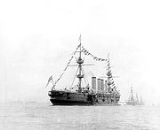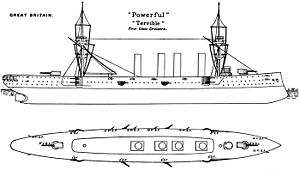
Powerful class cruiser
Encyclopedia
The Powerful class were first-class protected cruisers built for the British Royal Navy
Royal Navy
The Royal Navy is the naval warfare service branch of the British Armed Forces. Founded in the 16th century, it is the oldest service branch and is known as the Senior Service...
in the 1890s. There were two ships in the Powerful class, the lead ship Powerful
HMS Powerful (1895)
HMS Powerful was a ship of the Powerful-class of protected cruiser in the Royal Navy.-Career:She was built by Vickers Limited, Barrow-in-Furness and launched on 24 July 1895 by the Duchess of Devonshire....
and the Terrible
HMS Terrible (1895)
HMS Terrible was a ship of the Powerful-class of protected cruiser in the Royal Navy.-Terrible 1898 Trials:* 60 hours at 1/5 power 5084 ihp = * 68 hours at 2/5 power = * 60 hours at 3/5 power = * 60 hours at 3/4 power =...
.
Design

Rurik (1892)
The Rurik was an armoured cruiser built for the Imperial Russian Navy in 1895. She was named in honour of Rurik, the semi-legendary founder of ancient Russia...
and numerous French armoured cruisers of the era. As a result, these were very large cruisers intended to be able to dominate other cruisers in a one-on-one battle. A secondary function was to act as a high speed, long range transport (which in fact was their only actual use during war).
The original armament was to be a uniform battery of twenty 6 inch guns. However, the Director of Naval Ordnance strongly believed that fewer larger (8 inch) guns would produce a better ship. The Office of Naval Construction countered that a 6 inch gun was suitable for fighting other cruisers, and that the 8 inch gun was too slow-firing to fight cruisers yet too small to fight battleships. He asked for at least a few guns of at least 9.2 inches as the smallest capable of damaging a contemporary battleship. This argument won, and the armament as constructed became two 9.2 inch guns and twelve 6 inch guns. Observers criticized these ships for their apparently light armament given their size. However they had excellent sea keeping, high speed, and long range, all of which required space and tonnage.
These were the first four funnelled cruisers in the Royal Navy.
These ships had an armoured deck to stop plunging shells. This deck curved, with its crown in the middle of the ship 3ft 6in above the waterline, and the edges were 6ft 6in below the waterline. The deck was 6in thick over the machinery, 4in thick over the magazines, and 2.5in thick in the middle of the ship.
The dimensions of this class were limited by the then available dockyards available to build and maintain them.
In comparison to the Edgar class
Edgar class cruiser
The Edgar-class was a nine-ship class of protected cruiser built around 1891 for the Royal Navy.-Design:Crescent and Royal Arthur were built to a slightly modified design with a raised forecastle and a pair of 6 inch guns replacing the forward 9.2 inch gun, and are sometimes considered a...
, these ships had a crew 64% larger, cost 61% more to build, had more than twice the horsepower, had 660 tons of armour versus 340 tons, were two knots faster, but had very nearly the same armament. The Edgar class remained to fight during the First World War
World War I
World War I , which was predominantly called the World War or the Great War from its occurrence until 1939, and the First World War or World War I thereafter, was a major war centred in Europe that began on 28 July 1914 and lasted until 11 November 1918...
, but the Powerful class had left the active fleet by then.
Building Programme
The following table gives the build details and purchase cost of the members of the Powerful class. Standard British practice at that time was for these costs to exclude armament and stores.| Ship | Builder | Date of | Cost according to | |||
|---|---|---|---|---|---|---|
| Laid Down | Launch | Completion | (BNA Brassey's Naval Annual The Naval Annual was a book that sought to bring together a large amount of information on naval subjects, which had hitherto been obtainable only by consulting numerous publications and chiefly from foreign sources... 1904) |
(BNA 1906) | ||
| Powerful HMS Powerful (1895) HMS Powerful was a ship of the Powerful-class of protected cruiser in the Royal Navy.-Career:She was built by Vickers Limited, Barrow-in-Furness and launched on 24 July 1895 by the Duchess of Devonshire.... |
Vickers Vickers Vickers was a famous name in British engineering that existed through many companies from 1828 until 1999.-Early history:Vickers was formed in Sheffield as a steel foundry by the miller Edward Vickers and his father-in-law George Naylor in 1828. Naylor was a partner in the foundry Naylor &... , Barrow in Furness |
1894 | 24 Jul 1895 | 8 Jun 1897 | £741,870 | £705,335 |
| Terrible HMS Terrible (1895) HMS Terrible was a ship of the Powerful-class of protected cruiser in the Royal Navy.-Terrible 1898 Trials:* 60 hours at 1/5 power 5084 ihp = * 68 hours at 2/5 power = * 60 hours at 3/5 power = * 60 hours at 3/4 power =... |
J&G Thompson John Brown & Company John Brown and Company of Clydebank was a pre-eminent Scottish marine engineering and shipbuilding firm, responsible for building many notable and world-famous ships, such as the , the , the , the , the , and the... , Clydebank Clydebank Clydebank is a town in West Dunbartonshire, in the Central Lowlands of Scotland. Situated on the north bank of the River Clyde, Clydebank borders Dumbarton, the town with which it was combined to form West Dunbartonshire, as well as the town of Milngavie in East Dunbartonshire, and the Yoker and... |
1894 | 27 May 1895 | 24 Mar 1898 | £740,584 | £708,619 |
Trials
| Ship | Date | 4 hours forced draught |
30 hours natural draught |
Source | |||||
|---|---|---|---|---|---|---|---|---|---|
| Powerful HMS Powerful (1895) HMS Powerful was a ship of the Powerful-class of protected cruiser in the Royal Navy.-Career:She was built by Vickers Limited, Barrow-in-Furness and launched on 24 July 1895 by the Duchess of Devonshire.... |
1896 | 25,866 ihp | 21.8 kn (42.7 km/h) bad weather |
18,433 ihp | 20.6 kn (40.4 km/h) | Janes 1900 | |||
| Terrible HMS Terrible (1895) HMS Terrible was a ship of the Powerful-class of protected cruiser in the Royal Navy.-Terrible 1898 Trials:* 60 hours at 1/5 power 5084 ihp = * 68 hours at 2/5 power = * 60 hours at 3/5 power = * 60 hours at 3/4 power =... |
1897 | 25,572 ihp | 22.4 kn (43.9 km/h) | 18,493 ihp | 20.96 kn (41.1 km/h) | Janes 1900 | |||
Terrible 1898 Trials
- 60 hours at 1/5 power (20 boilers) 5084 ihp = 12.8 kn (25.1 km/h)
- 68 hours at 2/5 power 10,246 ihp = 17 kn (33.3 km/h)
- 60 hours at 3/5 power 15,554 ihp = 19.6 kn (38.4 km/h)
- 60 hours at 3/4 power 18,515 ihp = 20.3 kn (39.8 km/h)
- 8 hours (22,000 ihp nominal) = 23,053 ihp = 20.7 kn (40.6 km/h)
- 4 hours at full power = 25,513 ihp = 21.9 kn (42.9 km/h)
December 1898 sea trip, Portsmouth
Portsmouth
Portsmouth is the second largest city in the ceremonial county of Hampshire on the south coast of England. Portsmouth is notable for being the United Kingdom's only island city; it is located mainly on Portsea Island...
to Gibraltar
Gibraltar
Gibraltar is a British overseas territory located on the southern end of the Iberian Peninsula at the entrance of the Mediterranean. A peninsula with an area of , it has a northern border with Andalusia, Spain. The Rock of Gibraltar is the major landmark of the region...
, 12,500 ihp = 18 kn (35.3 km/h) average. Gibraltar
Gibraltar
Gibraltar is a British overseas territory located on the southern end of the Iberian Peninsula at the entrance of the Mediterranean. A peninsula with an area of , it has a northern border with Andalusia, Spain. The Rock of Gibraltar is the major landmark of the region...
to Malta
Malta
Malta , officially known as the Republic of Malta , is a Southern European country consisting of an archipelago situated in the centre of the Mediterranean, south of Sicily, east of Tunisia and north of Libya, with Gibraltar to the west and Alexandria to the east.Malta covers just over in...
, average 21.5 kn (42.1 km/h).
Careers
Both ships served in the China StationChina Station
The China Station was a historical formation of the British Royal Navy. It was formally the units and establishments responsible to the Commander-in-Chief, China....
and provided landing parties which fought in the relief of the Siege of Ladysmith
Siege of Ladysmith
The Siege of Ladysmith was a protracted engagement in the Second Boer War, taking place between 30 October 1899 and 28 February 1900 at Ladysmith, Natal.-Background:...
in the Second Boer War
Second Boer War
The Second Boer War was fought from 11 October 1899 until 31 May 1902 between the British Empire and the Afrikaans-speaking Dutch settlers of two independent Boer republics, the South African Republic and the Orange Free State...
in South Africa
South Africa
The Republic of South Africa is a country in southern Africa. Located at the southern tip of Africa, it is divided into nine provinces, with of coastline on the Atlantic and Indian oceans...
. This event inspired the Field gun competition
Field gun competition
The Royal Navy's field gun competition is a contest between teams from various Royal Navy commands, in which teams of sailors compete to transport a field gun and its equipment over and through a series of obstacles in the shortest time. The competition evolved during the first 6 years of the 20th...
. Crews from the two ships also took part in suppressing the Boxer Rebellion
Boxer Rebellion
The Boxer Rebellion, also called the Boxer Uprising by some historians or the Righteous Harmony Society Movement in northern China, was a proto-nationalist movement by the "Righteous Harmony Society" , or "Righteous Fists of Harmony" or "Society of Righteous and Harmonious Fists" , in China between...
in China. After 1904 they were laid up as an economy measure. During the First World War
World War I
World War I , which was predominantly called the World War or the Great War from its occurrence until 1939, and the First World War or World War I thereafter, was a major war centred in Europe that began on 28 July 1914 and lasted until 11 November 1918...
, they had most of their armament removed and served as troop transports and later accommodation ships.

